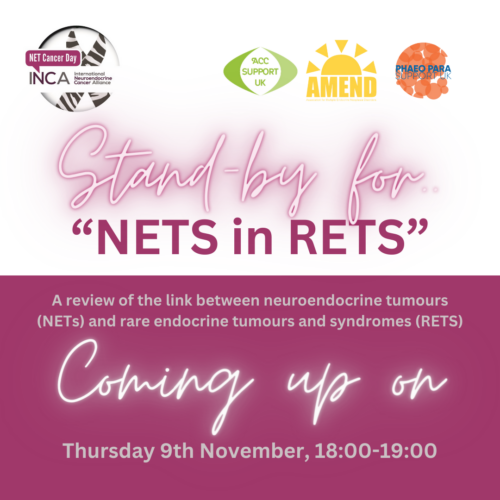Very often, ACC tumours are not found until they have grown quite large. This is different for children since they react more to the hormones these tumours make. Sometimes, ACC may be found early by coincidence when having tests or scans for other unrelated health problems Usually, ACC is found due to the symptoms caused by either the hormones they make or because the tumour has grown large and is pressing on other organs in the body.
What tests are needed?
These days, the first imaging test (scan) to be used is likely to be a CT scan. Other tests may be used to find out more about the size and spread of the tumour to nearby structures such as lymph nodes or to distant areas such as the liver and lungs. These tests help doctors to ‘stage’ the disease, i.e. how advanced it is, and to plan the right treatment or combination of treatments. Urine and blood tests are also essential to look for hormones that the tumour may be making.
One or more of the following tests may be done if the doctor thinks you may have an ACC:
CT scans (computed tomography): A CT scan uses x-rays to make detailed pictures of the inside of your body. Instead of taking just one x-ray, the doughnut-shaped CT scanner takes many pictures as it moves around you. A computer then combines these into a picture of a slice of your body. CT scans can show the adrenal glands and can often confirm whether a tumour is present, how large it is, and whether it has spread to nearby sites. CT scans also show the organs near the adrenal glands, as well as lymph nodes and distant organs. This test can help show if the cancer has spread to the liver or other organs. Before any pictures are taken, or after the first scan, you may also have an IV (intravenous) line put into your arm through which a contrast dye can be given. This helps the outline structures in your body look clearer. The contrast dye can cause some redness and a warm feeling that may last hours to days. A few people are allergic to the dye. Rarely, more serious reactions like breathing problems and low blood pressure can happen. Medicine can be given to prevent and treat these problems. Be sure to tell the doctor if you have ever had a reaction to any contrast substance used for CT scans before. CT scans take longer than regular x-rays and you need to lie still on a table while they are being done. A recent study recommended a urine steroid metabolomics test* together with ‘an unenhanced CT tumour attenuation cutoff of 20 HU should replace that of 10 HU for exclusion of ACC’.
PET scan (positron emission tomography): For a PET scan, a type of radioactive sugar is injected into your vein. The sugar collects in cancer cells and shows up in the pictures. This test is useful for finding ACC that has spread outside of the adrenal glands.
MRI (magnetic resonance imaging): MRI scans use radio waves and strong magnets to take pictures. The MRI sometimes gives similar information to a CT scan but may be more helpful because it can show views from different angles. In long term follow-up, MRIs may be used to avoid the repeated exposure to radiation from a CT scan. An MRI scan can take up to an hour to perform. Due to the tube-like shape of the MRI scanner, you might feel quite confined during your scan. If you have problems with tight spaces, tell the doctor before your MRI is set up; you may be able to have the test done using a less confined open MRI scanner. The machine makes loud thumping and clicking noises during the scan as the magnet switches on and off. You will be given earplugs or headphones, sometimes with music, to help block this out.
Chest x-ray: This can show if the cancer has spread to the lungs. This is also often done to check on your general health status before an operation.
Ultrasound: This test uses sound waves to make pictures of organs inside your body. A computer shows the picture on a screen. This test can show if there is a tumour in the adrenal gland or liver. This would not be the first choice of test as a CT scan would be preferred.
Blood and urine tests:
If there is a suspicion that the tumour is making increased amounts of hormones, then this can be measured in the bloodstream and/or in a urine collection as part of an initial hormone screening. Some hormone tests are done after patients have taken a synthetic steroid tablet called dexamethasone. It may also be possible to measure hormones that do not cause any effect on the body. All of these tests are equally useful after surgery to check that all of the tumour has been removed and, later on, to see if there is any evidence of the tumour returning (follow-up screening). In addition, it may be necessary to do more common blood tests to assess your general level of health.
- Full blood count
- Liver and kidney function
- Hormonal work-up
- Glucocorticoid levels
- Dexamethasone suppression test
- 24 hour urine collection text for free urinary cortisol
- Basal cortisol (serum)
- Basal ACTH (plasma)
- Sexual steroids and steroid precursors
- Serum DHEA-S, 17=OH-progesterone, Androstenedione and Testosterone
- 17-beta-oestradiol (serum, men and postmenopausal women only), 24 hour urine collection to measure steroid metabolites
- Mineralocorticoid levels
- Potassium (serum), aldosterone/renin ratio (only in those with arterial hypertension with or without hypokalaemia)
- Catecholamine levels
- Normetanephrines, metanephrines and methoxytyramines (plasma)
- Alternatively; fractionated metanephrine production (24 hour urine collection)
- Urine steroid metabolomics*
These tests or some of these tests may not be needed if it is already certain that you have ACC.
Biopsy
A biopsy is when a sample of tissue is removed with a fine needle to see whether cancer cells are in it (Fine Needle Aspiration or FNA). FNA should NOT be done in suspected cases of ACC since it usually does not give enough tissue to tell the difference between cancerous and non-cancerous growths. In addition, it is important that the tumour remains intact and piercing it by a biopsy may lead to tumour spread.
Patient Experience Film: Talking About ACC – Diagnosis
-
For more detailed information on all aspects of ACC, download our free patient information book.








